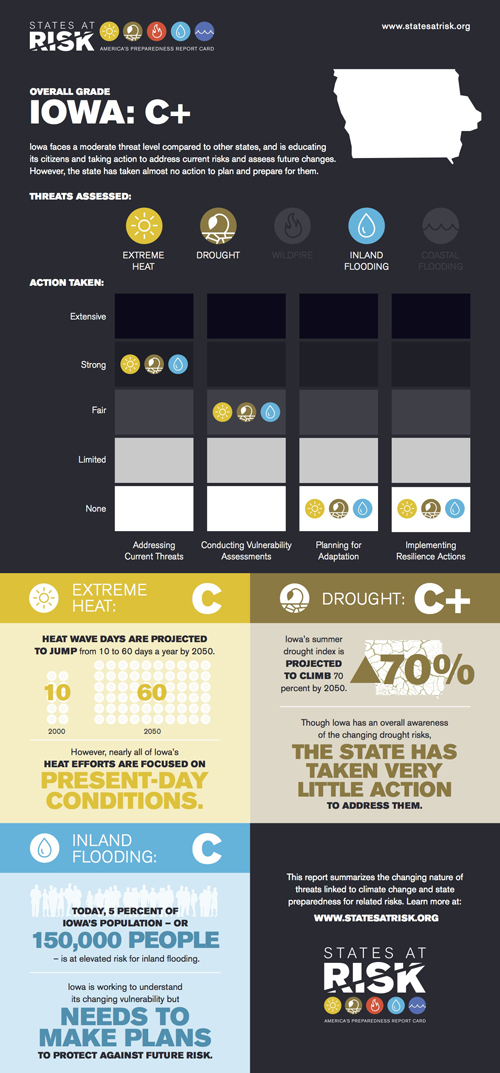Iowa's natural disaster preparedness
posted
on Tuesday, December 15, 2015
 Threats from carbon pollution rising over time may seem far away from Iowa. The reality, however, is they are costing Iowa today and will continue to pose numerous challenges in the future, including natural disasters from extreme weather.
Threats from carbon pollution rising over time may seem far away from Iowa. The reality, however, is they are costing Iowa today and will continue to pose numerous challenges in the future, including natural disasters from extreme weather.
A recently released report revealed Iowa's preparedness to face the significant and increasing risks posed by changing levels of extreme weather, including extreme heat, drought and inland flooding is lacking. Overall, Iowa received C+ grade for States at Risk: America’s Preparedness Report Card, the first-ever quantitative assessment of its kind. The report was prepared by the States at Risk Project, a collaboration of ICF International and Climate Central, and was designed to help provide a benchmark for states to assess risks, build and implement action plans to increase their preparedness levels.
Specifically, Iowa was measured on its preparedness to deal with three threats – extreme heat, drought and inland flooding threats. The state received a C for extreme heat, C+ for drought and C for inland flooding threats. The report’s biggest criticism of Iowa was of its lack of adequate planning and implementing solutions that will mitigate the effects of extreme weather.
Yet, panelists at the States at Risk announcement also indicated Iowa is working to improve its preparedness. Des Moines Mayor Frank Cownie used the city’s own fight against flooding as an example.
“While the City of Des Moines works tirelessly to upgrade infrastructure to mitigate natural disasters like flooding, we must also address the underlying carbon pollution issues that are causing more frequent occurrences,” said Mayor Cownie. “Data over the past several decades shows a dramatic increase in the flow of water to Des Moines, so we must work to address issues upstream as well.”
Since the 1980s, the annual number of disasters costing more than $1 billion has nearly tripled, from less than three to more than eight a year (adjusted for inflation). The cost of recovery from these events is much higher than investing in preparedness before they happen. Between 2011 and 2013, the federal government spent $136 billion – or almost $400 in taxes from each American household each year – on disaster relief. Improving our disaster preparedness and cutting carbon pollution will protect Iowa’s communities, strengthen our economy and preserve our working lands.
So what’s next? That remains to be determined: Iowa may have received a C+ in this report, but it also confirms Iowans across the state are committed to finding solutions that will keep our communities safe and protected.
- carbon pollution